Days Four and Five in Barcelona were actually spent day tripping outside the city. Yesterday we ventured an hour west to Catalan wine county, Sant Sadurni d’Anoia, which is famous for its white, sparkling wine called Cava.

Cava is essentially a Spanish champagne. It tends to be less acidic than most champagnes and less fruity than most proseccos. After a nice hike through town, we were able to tour the Codorníu winery and the cellar caves where cava has been produced and stored since 1551. The tour concluded with a walk and ride through the cellar caves (dug by hand with picks and axes).
The cellar caves were dark and eerie and so large that they had their own street names to prevent staff from getting lost. M was mostly a good sport and even quietly enjoyed some screen time while Josh and I participated in a cava and cheese tasting.

Though our original plans included a few more cava tastings at other local wineries, we felt it best not to press our luck with M’s toddler attention span and headed back to Barcelona proper after a few playground stops along the way to the train station.
For dinner we treated M to another round of tapas and finally met her request for paella. Paella is a traditional Spanish rice dish prepared in a large dish often with seafood or other meats. I knew M was a big fan of seafood so we opted for the traditional seafood version.

“Paella for Two” was basically only enjoyed by one (and it wasn’t me!). M loved the dish so much she ate all of the clams, all of the squid, all (but one) of mussels and all three of the giant prawns. I can at least tell you that the rice was good!
Josh had a hamburger.
Today, we’ve once again left the city, this time venturing slightly north of Barcelona to the mountain town of Monserrat. Home to a Benedictine Monastery (still housing around 70 monks) and the legend of the Virgin of Montserrat.

The story goes that in the 800s some shepherds saw fireballs shooting out of a mountainous cave on Monserrat. They followed the lights and found “La Moreneta” (little Madonna) inside the cave. They removed the statute from he cave and begin heading toward the nearby city Manresa. However, the closer they got to Manresa, the heavier and heavier the Madonna statue became until they were unable to move it further. Realizing the statue wanted to be in the mountains she was returned to the location where the monastery is now located. When the monks founded the monastery in 1025, legend further says, they had to build the monastery around the statue as it was too heavy to move.
Recent research has dated the creation of the statue to the year 50 AD based on a reference in literature. The statue was taken to Egypt at some point. Then, later, in 718 AD was transported to Barcelona to protect it from an invasion by the Moors. From there it was hidden and not uncovered until it was found in the cave in the 880s.

Like the shepherds in the Morenetq legend, we made our way down the mountain and headed to the medieval city of Manresa (though we travelled 30 minutes by train). It was getting later in the day so our exploration of the city was unfortunately a bit rushed.
We did have a chance to see the 12th century city walls which are some of the best preserved in the world from that time period.

We also ventured up the hill to the 14th century Basilica of Santa Maria de La Seu. Work began on the church in 1325 but wasn’t completed until the last 1600s. The main facade was redesigned by a Spanish architect in the early 1930s based off an idea belonging to Gaudí. The church is actually built atop a cave where Saint Ignatius of Loyola (founder of the Jesuits) shut himself inside for an extended period of prayer and reflection.

M was more than ready for bed after this long day so it’s takeaway dinner for her and plans for a glass of cava on the hotel room balcony once she’s sleeping for us!
Commenti